Flexibility: Yoga
Why it’s essential: Studies show that yoga significantly improves flexibility, balance, and muscular strength and endurance, giving you the ability to exercise longer. Yoga may also help control physiological variables such as blood pressure, respiration and heart rate, and speed up your metabolic rate to help you maintain a healthy weight. There are a number of different styles and types of yoga you can practise, says Calgary-based personal trainer Helen Vanderburg. “If stress reduction is your goal, a restorative yoga class is good. If you want a tough workout, I recommend either Ashtanga or a fusion fitness class.”
Technique and tips: “Each yoga posture involves a different focus for the body,” says Vanderburg. The standing postures build strength of the legs and core as well as flexibility of the lower body-especially the hamstrings, hip flexors and adductors (inner thighs). Forward bends, back bends and twists work on strength and flexibility of the spine and pelvis as well as the surrounding muscles. Inversions-where the head is below the heart and feet in relation to gravity-have a wide range of benefits for the nervous system.
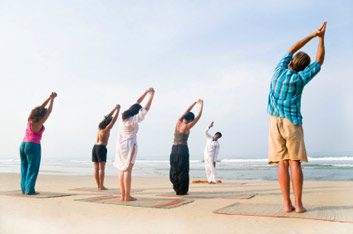
Flexibility: Yoga
Why it’s essential: Studies show that yoga significantly improves flexibility, balance, and muscular strength and endurance, giving you the ability to exercise longer. Yoga may also help control physiological variables such as blood pressure, respiration and heart rate, and speed up your metabolic rate to help you maintain a healthy weight. There are a number of different styles and types of yoga you can practise, says Calgary-based personal trainer Helen Vanderburg. “If stress reduction is your goal, a restorative yoga class is good. If you want a tough workout, I recommend either Ashtanga or a fusion fitness class.”
Technique and tips: “Each yoga posture involves a different focus for the body,” says Vanderburg. The standing postures build strength of the legs and core as well as flexibility of the lower body-especially the hamstrings, hip flexors and adductors (inner thighs). Forward bends, back bends and twists work on strength and flexibility of the spine and pelvis as well as the surrounding muscles. Inversions-where the head is below the heart and feet in relation to gravity-have a wide range of benefits for the nervous system.
Cardiovascular: Walking
Why it’s essential: Walking has been shown in studies to be associated with many health benefits, including lower rates of heart disease, stroke and type 2 diabetes. As well, studies found walking just 30 minutes a day, a few days a week, boosted bone density in women.
Technique and tips: Walking should be brisk (typically 5-6 km/h for most people-not strolling), and challenging enough that you feel a little out of breath but can still carry on a conversation. “I encourage walkers to clench their glutes as they walk, and to engage muscles in their upper back to get a better workout and a faster speed. This will also improve posture,” says Toronto-based walking coach Lee Scott.
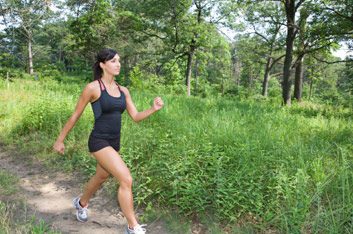
Cardiovascular: Walking
Why it’s essential: Walking has been shown in studies to be associated with many health benefits, including lower rates of heart disease, stroke and type 2 diabetes. As well, studies found walking just 30 minutes a day, a few days a week, boosted bone density in women.
Technique and tips: Walking should be brisk (typically 5-6 km/h for most people-not strolling), and challenging enough that you feel a little out of breath but can still carry on a conversation. “I encourage walkers to clench their glutes as they walk, and to engage muscles in their upper back to get a better workout and a faster speed. This will also improve posture,” says Toronto-based walking coach Lee Scott.
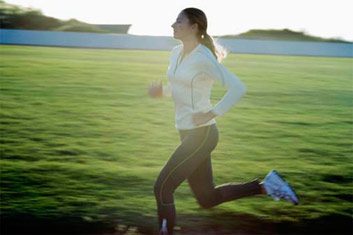
Cardiovascular: Running
Why it’s essential: Running is the gold standard for total calories burned per minute over all other activities,”
California-based personal trainer Jay Blahnik says. The calories you burn vary depending on your body weight and the intensity of your run, but a good rule of thumb is 100 calories per mile (that’s 60 calories per kilometre). Says Blahnik, “You don’t have to run very far, or very fast, to burn a good amount of calories.”
Technique and tips: Many people avoid running for fear of the impact on knees and joints. “Running gets a bad rap,” says Blahnik. “Yes, there is impact with running; however, in terms of our body’s biomechanics, it is a natural movement that we were designed to do.” To prevent knee injury, make sure you are running in proper shoes that have been fitted by an expert. Mix up the impact by sometimes choosing treadmills over outdoors, and if you’re outdoors, head for trails rather than hard surfaces, which have a greater impact on the joints. “You can focus on having a ‘quieter’ running stride-meaning, if you think about landing softly, you will land more softly,” says Blahnik. Finally, some people have injuries or biomechanical issues that make running more difficult; a sports physician will be able to detect if your legs are properly aligned for the activity.
Strength-building: The Squat
Why it’s essential: The squat is rated, time and again, as one of the most effective exercises for toning the legs, including the quadriceps in the front of the thighs, the hamstrings in the back, and the gluteus maximus in the buttocks.
Technique and tips: “The squat gives different results depending on your body type,” says Frederic Delavier, a personal trainer and author based in France. “If you have long limbs, the squat will mainly act on the glutes and lower back; if you have shorter limbs, it will work the quadriceps muscles more.”
Here’s the basic squat technique: Stand with feet hip width apart with a chair behind you. Slowly lower your hips as if you are about to sit, but just before your body touches the chair, return slowly to a standing position. Keep your back straight, and try not to let your knees go past your toes. “If you have knee or joint problems, vary the depth of the squat to only a few degrees, and progress gradually,” says Sherri McMillan, a personal trainer based in Washington state.
Strength-building: The Squat
Why it’s essential: The squat is rated, time and again, as one of the most effective exercises for toning the legs, including the quadriceps in the front of the thighs, the hamstrings in the back, and the gluteus maximus in the buttocks.
Technique and tips: “The squat gives different results depending on your body type,” says Frederic Delavier, a personal trainer and author based in France. “If you have long limbs, the squat will mainly act on the glutes and lower back; if you have shorter limbs, it will work the quadriceps muscles more.”
Here’s the basic squat technique: Stand with feet hip width apart with a chair behind you. Slowly lower your hips as if you are about to sit, but just before your body touches the chair, return slowly to a standing position. Keep your back straight, and try not to let your knees go past your toes. “If you have knee or joint problems, vary the depth of the squat to only a few degrees, and progress gradually,” says Sherri McMillan, a personal trainer based in Washington state.
Strength-building: The Squat
Why it’s essential: The squat is rated, time and again, as one of the most effective exercises for toning the legs, including the quadriceps in the front of the thighs, the hamstrings in the back, and the gluteus maximus in the buttocks.
Technique and tips: “The squat gives different results depending on your body type,” says Frederic Delavier, a personal trainer and author based in France. “If you have long limbs, the squat will mainly act on the glutes and lower back; if you have shorter limbs, it will work the quadriceps muscles more.”
Here’s the basic squat technique: Stand with feet hip width apart with a chair behind you. Slowly lower your hips as if you are about to sit, but just before your body touches the chair, return slowly to a standing position. Keep your back straight, and try not to let your knees go past your toes. “If you have knee or joint problems, vary the depth of the squat to only a few degrees, and progress gradually,” says Sherri McMillan, a personal trainer based in Washington state.
Strength-building: The Squat
Why it’s essential: The squat is rated, time and again, as one of the most effective exercises for toning the legs, including the quadriceps in the front of the thighs, the hamstrings in the back, and the gluteus maximus in the buttocks.
Technique and tips: “The squat gives different results depending on your body type,” says Frederic Delavier, a personal trainer and author based in France. “If you have long limbs, the squat will mainly act on the glutes and lower back; if you have shorter limbs, it will work the quadriceps muscles more.”
Here’s the basic squat technique: Stand with feet hip width apart with a chair behind you. Slowly lower your hips as if you are about to sit, but just before your body touches the chair, return slowly to a standing position. Keep your back straight, and try not to let your knees go past your toes. “If you have knee or joint problems, vary the depth of the squat to only a few degrees, and progress gradually,” says Sherri McMillan, a personal trainer based in Washington state.
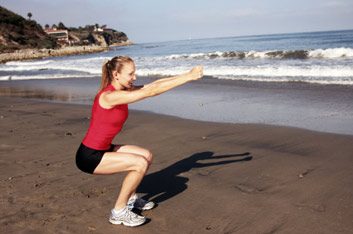
Strength-building: The Squat
Why it’s essential: The squat is rated, time and again, as one of the most effective exercises for toning the legs, including the quadriceps in the front of the thighs, the hamstrings in the back, and the gluteus maximus in the buttocks.
Technique and tips: “The squat gives different results depending on your body type,” says Frederic Delavier, a personal trainer and author based in France. “If you have long limbs, the squat will mainly act on the glutes and lower back; if you have shorter limbs, it will work the quadriceps muscles more.”
Here’s the basic squat technique: Stand with feet hip width apart with a chair behind you. Slowly lower your hips as if you are about to sit, but just before your body touches the chair, return slowly to a standing position. Keep your back straight, and try not to let your knees go past your toes. “If you have knee or joint problems, vary the depth of the squat to only a few degrees, and progress gradually,” says Sherri McMillan, a personal trainer based in Washington state.
Strength-building: The Crunch (or any ab exercise)
Why it’s essential: Your abdominal muscles increase your overall strength and power, help stabilize your torso and can help alleviate back pain. Abdominal exercises can help strengthen weak parts of the body and take pressure away from the back. Strong abdominals also help you maintain good posture.
Technique and tips: The effectiveness of any abdominal exercise will vary from person to person, and will depend on factors such as level of athleticism and past injuries. “It is hard picking one abdominal exercise, because you have to train all three planes of your abdominals-your rectus abdominis [the front abs or “six-pack” abs], your obliques [the sides] and your transversus abdominis [the inner abdominals],” says Harley Pasternak, a celebrity trainer based in California. Your abdominal muscles, like any other muscle group, will need recovery time between workouts.
Pasternak’s two-in-one exercise is a crunch with a twist. Lie flat on your back and lift your shoulders off the ground, curling your abdominals. At the top, rotate your left shoulder to the right side, then rotate back to centre and release back to the floor. Switch sides, and repeat. “You’re working your rectus abdominis and your transversus, while flexing and rotating your core,” says Pasternak.
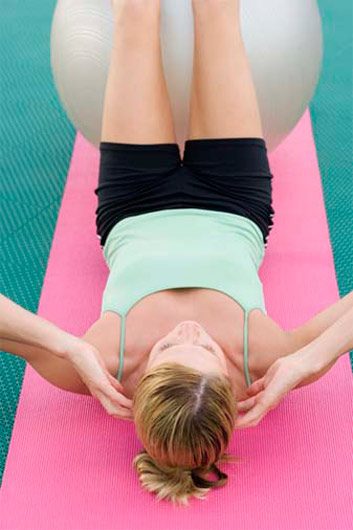
Strength-building: The Crunch (or any ab exercise)
Why it’s essential: Your abdominal muscles increase your overall strength and power, help stabilize your torso and can help alleviate back pain. Abdominal exercises can help strengthen weak parts of the body and take pressure away from the back. Strong abdominals also help you maintain good posture.
Technique and tips: The effectiveness of any abdominal exercise will vary from person to person, and will depend on factors such as level of athleticism and past injuries. “It is hard picking one abdominal exercise, because you have to train all three planes of your abdominals-your rectus abdominis [the front abs or “six-pack” abs], your obliques [the sides] and your transversus abdominis [the inner abdominals],” says Harley Pasternak, a celebrity trainer based in California. Your abdominal muscles, like any other muscle group, will need recovery time between workouts.
Pasternak’s two-in-one exercise is a crunch with a twist. Lie flat on your back and lift your shoulders off the ground, curling your abdominals. At the top, rotate your left shoulder to the right side, then rotate back to centre and release back to the floor. Switch sides, and repeat. “You’re working your rectus abdominis and your transversus, while flexing and rotating your core,” says Pasternak.
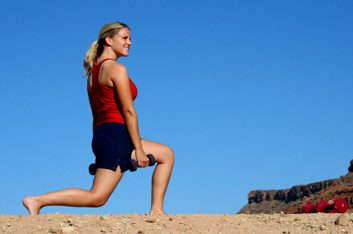
Strength-building: The Lunge
Why it’s essential: Research shows that lunges rival squats as the ultimate lower-body exercise to tone glutes, quadriceps and hamstrings.
Technique and tips: To do a basic lunge, take one step forward and drop your rear knee almost to the floor, making sure to keep the front heel on the floor and that knee directly over the centre of that foot. Slowly return to a standing position. Repeat with the other leg. “I like the lunge because it is a multi-joint exercise,” says Pasternak. “The fact that the lunge involves your glutes, quads and hamstrings means there is a lot of synergy in your lower body. This is a great leg strengthener.”
Strength-building: The Push-Up
Why it’s essential: The push-up requires no equipment, and conditions the chest, shoulders and triceps, while demanding core-muscle activation. “With push-ups you are using your own body weight and targeting a number of different muscles, giving you a lot of bang for your buck,” says McMillan.
Technique and tips: “Push-ups are easy to modify, making them a great exercise from beginner to expert,” says Vancouver-based personal trainer and fitness speaker Geoff Bagshaw. If you’re a beginner, lie on your stomach with your hands set slightly wider than your shoulders. Push your upper body off the floor, maintaining a straight line from head to toes (or, if you can’t manage that, from head to knees). “If you can, try to start out by doing it from the toes, and see how many repetitions you can do before dropping to your knees,” says Bagshaw.
Related Features:
• 8 ab-firming moves for two
• 9 moves for strong, sexy legs
• 7 ways to maximize your workout
Strength-building: The Push-Up
Why it’s essential: The push-up requires no equipment, and conditions the chest, shoulders and triceps, while demanding core-muscle activation. “With push-ups you are using your own body weight and targeting a number of different muscles, giving you a lot of bang for your buck,” says McMillan.
Technique and tips: “Push-ups are easy to modify, making them a great exercise from beginner to expert,” says Vancouver-based personal trainer and fitness speaker Geoff Bagshaw. If you’re a beginner, lie on your stomach with your hands set slightly wider than your shoulders. Push your upper body off the floor, maintaining a straight line from head to toes (or, if you can’t manage that, from head to knees). “If you can, try to start out by doing it from the toes, and see how many repetitions you can do before dropping to your knees,” says Bagshaw.
Related Features:
• 8 ab-firming moves for two
• 9 moves for strong, sexy legs
• 7 ways to maximize your workout
Strength-building: The Push-Up
Why it’s essential: The push-up requires no equipment, and conditions the chest, shoulders and triceps, while demanding core-muscle activation. “With push-ups you are using your own body weight and targeting a number of different muscles, giving you a lot of bang for your buck,” says McMillan.
Technique and tips: “Push-ups are easy to modify, making them a great exercise from beginner to expert,” says Vancouver-based personal trainer and fitness speaker Geoff Bagshaw. If you’re a beginner, lie on your stomach with your hands set slightly wider than your shoulders. Push your upper body off the floor, maintaining a straight line from head to toes (or, if you can’t manage that, from head to knees). “If you can, try to start out by doing it from the toes, and see how many repetitions you can do before dropping to your knees,” says Bagshaw.
Related Features:
• 8 ab-firming moves for two
• 9 moves for strong, sexy legs
• 7 ways to maximize your workout
Strength-building: The Push-Up
Why it’s essential: The push-up requires no equipment, and conditions the chest, shoulders and triceps, while demanding core-muscle activation. “With push-ups you are using your own body weight and targeting a number of different muscles, giving you a lot of bang for your buck,” says McMillan.
Technique and tips: “Push-ups are easy to modify, making them a great exercise from beginner to expert,” says Vancouver-based personal trainer and fitness speaker Geoff Bagshaw. If you’re a beginner, lie on your stomach with your hands set slightly wider than your shoulders. Push your upper body off the floor, maintaining a straight line from head to toes (or, if you can’t manage that, from head to knees). “If you can, try to start out by doing it from the toes, and see how many repetitions you can do before dropping to your knees,” says Bagshaw.
Related Features:
• 8 ab-firming moves for two
• 9 moves for strong, sexy legs
• 7 ways to maximize your workout
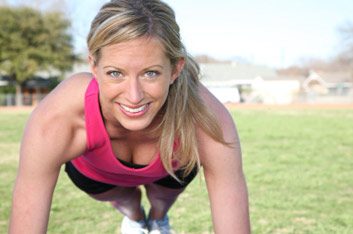
Strength-building: The Push-Up
Why it’s essential: The push-up requires no equipment, and conditions the chest, shoulders and triceps, while demanding core-muscle activation. “With push-ups you are using your own body weight and targeting a number of different muscles, giving you a lot of bang for your buck,” says McMillan.
Technique and tips: “Push-ups are easy to modify, making them a great exercise from beginner to expert,” says Vancouver-based personal trainer and fitness speaker Geoff Bagshaw. If you’re a beginner, lie on your stomach with your hands set slightly wider than your shoulders. Push your upper body off the floor, maintaining a straight line from head to toes (or, if you can’t manage that, from head to knees). “If you can, try to start out by doing it from the toes, and see how many repetitions you can do before dropping to your knees,” says Bagshaw.
Related Features:
• 8 ab-firming moves for two
• 9 moves for strong, sexy legs
• 7 ways to maximize your workout
